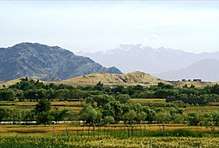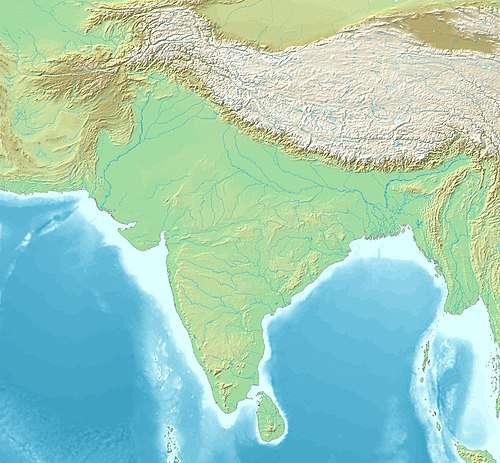Pul-i-Darunteh Aramaic inscription
The Pul-i-Darunteh Aramaic inscription, also called Aramaic inscription of Lampaka, is an inscription on a rock in the valley of Laghman ("Lampaka" being the transcription in Sanskrit of "Laghman"), Afghanistan, written in Aramaic by the Indian emperor Ashoka around 260 BCE. It was discovered in 1932 at a place called Pul-i-Darunteh. Since Aramaic was the official language of the Achaemenid Empire, which disappeared in 320 BCE with the conquests of Alexander the Great, it seems that this inscription was addressed directly to the populations of this ancient empire still present in northwestern India, or to border populations for whom Aramaic remained the language of use.[1]
| Pul-i-Darunteh Aramaic inscription | |
|---|---|
 Pul-i-Darunteh Aramaic inscription | |
| Material | Natural stone. |
| Writing | Aramaic |
| Created | circa 260 BCE |
| Period/culture | 3rd Century BCE |
| Discovered | 34.5846°N 70.1834°E |
| Place | Pul-i-Darunteh, Laghman Province, Afghanistan |
| Present location | Pul-i-Darunteh, Laghman Province, Afghanistan |


Background
The discovery of this inscription in 1932 is one of a set of similar inscriptions in Aramaic or Greek (or both together), written by Asoka. In 1915, Sir John Marshall had discovered the Aramaic Inscription of Taxila. In 1958 the famous Bilingual Kandahar Inscription, written in Greek and Aramaic was discovered, and in 1963 the Greek Edicts of Ashoka, again in [[Kandahar]. In the same year 1963 and again in Kandahar, an inscription in "Indo-Aramaic" known as the Kandahar Aramaic inscription or Kandahar II was found, in which the Indian Prakrit language and the Aramaic language alternate, but using only the Aramaic script. The Aramaic parts translate the Indian parts transcribed in the Aramaic alphabet. In 1969, two Belgian anthropologists by chance discovered another Aramaic edict, Aramaic Inscription of Laghman or Lahman I. A few years later, in 1973, Lahmann II followed.[2]
Content of the inscription
The inscription is incomplete. However, the place of discovery, the style of the writing, the vocabulary used, makes it possible to link the inscription to the other Ashoka inscriptions known in the region. In the light of other inscriptions, it has been found that the Pul-i-Darunteh inscription consists of a juxtaposition of Indian and Aramaic languages, all in Aramaic script, and the latter representing translations of the first.[3] This inscription is generally interpreted as a translation of a passage of the Major Pillar Edicts n°5 or n°7,[4] although others have proposed to categorize it among the Minor Rock Edicts of Ashoka.[5]
See also
- List of Ashoka Edicts
- Kandahar Bilingual Rock Inscription
- Asoka - the Buddhist Emperor of India /Chapter 4 by Vincent Arthur Smith: The Rock Edicts (this version)
References
- A new Aramaic inscription of Asoka found in the Laghman Valley (Afghanistan), André Dupont-Sommer Proceedings of the Academy of Inscriptions and Belles-Lettres Year 1970 114-1 p.173
- History of Discoveries and identifications from M. Boyce / F. Grenet, A History of Zoroastrianism, Zoroastrianism under Macedonian and Roman Rule, 1991.
- Essenism and Buddhism, Dupont-Sommer, André, Proceedings of the Academy of Inscriptions and Belles-Lettres Year 1980 124-4 pp.698-715 p.706
- Handbuch der Orientalistik by Kurt A. Behrendt [https: //books.google.com/books?id=C9_vbgkzUSkC&pg=PA39 p.39]
- Inscriptions of Asoka from DC Sircar p.33
| Edicts of Ashoka (Ruled 269–232 BCE) | |||||
| Regnal years of Ashoka |
Type of Edict (and location of the inscriptions) |
Geographical location | |||
| Year 8 | End of the Kalinga war and conversion to the "Dharma" |  Udegolam Nittur Brahmagiri Jatinga Rajula Mandagiri Yerragudi Sasaram Barabar Kandahar (Greek and Aramaic) Kandahar Khalsi Ai Khanoum (Greek city) | |||
| Year 10[1] | Minor Rock Edicts | Related events: Visit to the Bodhi tree in Bodh Gaya Construction of the Mahabodhi Temple and Diamond throne in Bodh Gaya Predication throughout India. Dissenssions in the Sangha Third Buddhist Council In Indian language: Sohgaura inscription Erection of the Pillars of Ashoka | |||
| Kandahar Bilingual Rock Inscription (in Greek and Aramaic, Kandahar) | |||||
| Minor Rock Edicts in Aramaic: Laghman Inscription, Taxila inscription | |||||
| Year 11 and later | Minor Rock Edicts (n°1, n°2 and n°3) (Panguraria, Maski, Palkigundu and Gavimath, Bahapur/Srinivaspuri, Bairat, Ahraura, Gujarra, Sasaram, Rajula Mandagiri, Yerragudi, Udegolam, Nittur, Brahmagiri, Siddapur, Jatinga-Rameshwara) | ||||
| Year 12 and later[1] | Barabar Caves inscriptions | Major Rock Edicts | |||
| Minor Pillar Edicts | Major Rock Edicts in Greek: Edicts n°12-13 (Kandahar) Major Rock Edicts in Indian language: Edicts No.1 ~ No.14 (in Kharoshthi script: Shahbazgarhi, Mansehra Edicts (in Brahmi script: Kalsi, Girnar, Sopara, Sannati, Yerragudi, Delhi Edicts) Major Rock Edicts 1-10, 14, Separate Edicts 1&2: (Dhauli, Jaugada) | ||||
| Schism Edict, Queen's Edict (Sarnath Sanchi Allahabad) Lumbini inscription, Nigali Sagar inscription | |||||
| Year 26, 27 and later[1] |
Major Pillar Edicts | ||||
| In Indian language: Major Pillar Edicts No.1 ~ No.7 (Allahabad pillar Delhi pillar Topra Kalan Rampurva Lauria Nandangarh Lauriya-Araraj Amaravati) Derived inscriptions in Aramaic, on rock: | |||||